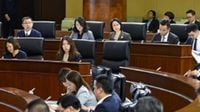Finland has found itself thrust into the center of Europe’s evolving security landscape, as tensions with Russia remain high and the search for peace in Ukraine grows ever more elusive. On November 27, 2025, Finland’s Foreign Minister Elina Valtonen addressed these complex issues in an interview with Al Jazeera, offering insight into the prospects for a Russia-Ukraine peace deal, the role of former U.S. President Donald Trump, and the unique challenges faced by Finland as a NATO member sharing a long and heavily guarded border with Russia.
Valtonen did not mince words about the current state of play. When asked about the possibility of a negotiated end to the war in Ukraine, she was blunt: "Moscow is still not interested in genuine peace." According to Al Jazeera, Valtonen emphasized that any realistic settlement would require Russia to demonstrate a sincere willingness to negotiate—a step she believes the Kremlin has yet to take.
Finland’s perspective is shaped by geography as much as by politics. The Nordic nation shares a 1,340-kilometre (830-mile) border with Russia, a fact that has dictated its security policies for decades. Since joining NATO, Finland’s position has become even more pivotal. As Valtonen explained, Europe—and especially NATO’s eastern flank—insists on “clear red lines” when it comes to Russian aggression. This insistence is not just rhetorical; it is backed up by concrete measures on the ground.
One such measure is the ongoing construction of a 200-kilometre fence along Finland’s border with Russia. According to reporting from AFP, the fence, which is due for completion in 2026, comes with a hefty price tag—380 million euros, or roughly 441 million U.S. dollars. The project was set in motion after Finland closed its entire border with Russia in December 2023, a direct response to the Kremlin’s invasion of Ukraine and the subsequent spike in tensions between the two neighbors.
The closure of the border has not entirely stemmed the flow of people between the two countries, however. On November 27, 2025, Finland’s border guard apprehended a man suspected of illegally crossing from Russia into Finland near the southeastern border town of Imatra. The operation, which involved vehicles, dog patrols, and even a helicopter, was launched after patrols discovered fresh tracks in the snow-covered forest north of Immalanjarvi lake. "These traces appeared to be quite fresh, which is why a search was launched," said Pinja Viskari of the Southeast Finland Border Guard, speaking to AFP.
While the border remains officially closed, individual crossings have still occurred throughout 2025. Viskari noted that the most recent incident prior to November happened at the beginning of September, when someone crossed from Finland into Russia. Such crossings are rare but underscore the ongoing risks and the need for vigilance along the frontier.
The border issue is not limited to clandestine crossings. Earlier in the month, on November 14, Finnish authorities deported a Russian man who had crossed the border in June and subsequently applied for asylum. Media reports identified the individual as a former Wagner mercenary, adding another layer of complexity—and potential danger—to the situation. The presence of ex-combatants and the possibility of infiltration have only heightened Finnish concerns about border security.
But border security is just one piece of a much larger puzzle. In her interview with Al Jazeera, Valtonen highlighted the importance of NATO deterrence and the need for unity within the alliance. Finland’s accession to NATO in 2023 marked a historic shift for the country, which had previously maintained a policy of military non-alignment. The move was prompted by Russia’s aggression in Ukraine and a growing sense among Finnish leaders that neutrality was no longer a viable option.
Valtonen also addressed the contentious issue of frozen Russian assets. Since the start of the war, the European Union has seized billions of euros in Russian state and oligarch assets. The question of what to do with these frozen funds—whether to use them for Ukraine’s reconstruction, as leverage in negotiations, or to hold them as a bargaining chip—remains a point of debate within the EU. Valtonen suggested that Europe must remain firm, using all available tools to pressure Moscow while maintaining unity among member states.
The possibility of diplomatic breakthroughs remains remote, at least for now. Some observers have floated the idea that Donald Trump, should he return to the White House, might be able to broker a deal between Russian President Vladimir Putin and Ukrainian President Volodymyr Zelenskyy. Valtonen was cautious on this point, acknowledging the outsized influence that American leadership can have on European security but warning against over-optimism. "Whether Trump can bring Putin and Zelenskyy to the negotiating table is still very much an open question," she remarked.
This uncertainty is echoed across Europe, where leaders are acutely aware of the stakes involved. For countries like Finland, which sits on the literal front line, the risks are not theoretical. The construction of the border fence, the closure of crossing points, and the heightened alert among border guards all reflect a new reality—one in which the threat of Russian aggression looms large and the margin for error is slim.
Yet, amidst the anxiety, there is also a sense of determination. Finland’s response to the crisis—both in terms of physical security and diplomatic engagement—demonstrates a commitment to upholding European stability and resisting Russian pressure. As Valtonen put it, "Europe insists on clear red lines," a message that resonates not only in Helsinki but in capitals across the continent.
Looking ahead, the completion of the border fence in 2026 will mark a significant milestone for Finland. It is a tangible sign of the country’s resolve to protect its sovereignty and contribute to the broader security of the NATO alliance. At the same time, the ongoing search for a durable peace in Ukraine remains fraught with challenges. As long as Moscow shows little interest in genuine negotiations, the prospects for a breakthrough will remain uncertain.
For now, Finland continues to walk a delicate line—balancing deterrence with diplomacy, vigilance with openness, and national security with its responsibilities as a member of the European and transatlantic communities. The events of November 2025, from high-level diplomatic statements to dramatic scenes on the snowy border, serve as a stark reminder that the shadow of war still hangs over Europe—and that the work of building peace is far from finished.




